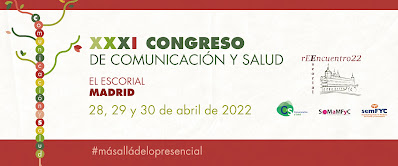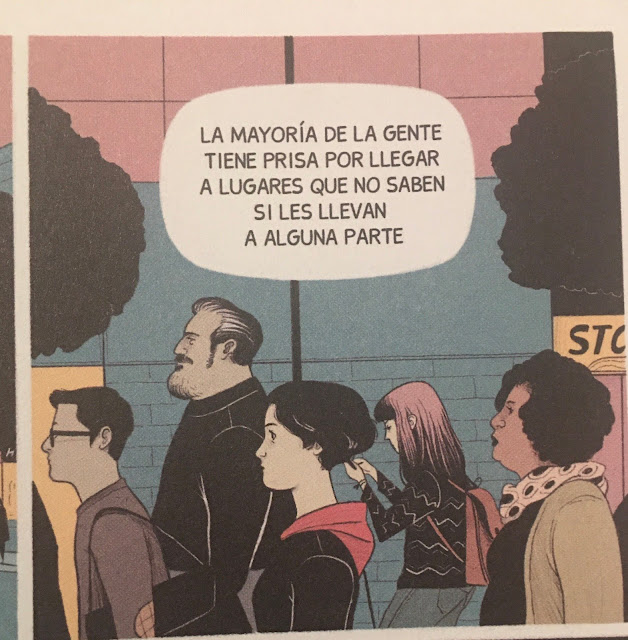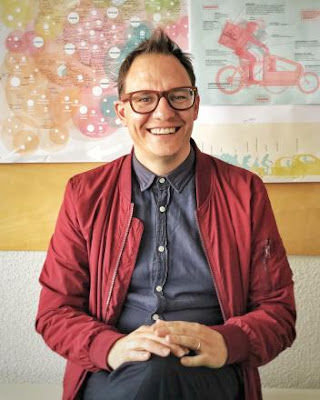Tras asistir al congreso de comunicación de la Semfyc tras dos años sin actividad comparto mi alegría y alguna reflexión.
El congreso tuvo lugar en el Escorial y convocó a 350 asistentes con un formato de talleres y mesas participativas. Asistí a cuatro talleres (de 2,3 y 4 horas, sobre actividad grupal para pacientes, medicina narrativa, metodología con infografías para dolor crónico y desarrollo artístico) y defendí una comunicación oral sobre el ruido y una mesa de 3 horas sobre el silencio (por cierto tuve que hacer ambas cosas al mismo tiempo, pero eso ya lo contaremo otro día). El nivel, como suele ser habitual, muy alto, tanto en ponentes como en participantes, y esto lo digo por el alto valor de los encuentros de pasillo, comidas y demás que añaden un gran plus a este tipo de encuentros.
Hoy con un poco de perspectiva, tras alejarme varios cientos de kilómetros por causa mayor (me perderé la conferencia de clausura y las valiosas reseñas bibliográficas de Francesc Borrell) puedo preguntarme si a nuestro sistema sanitario y a nuestra sociedad les hace falta más comunicación o menos, en tiempos de tanto ruido.
Y empezaré mirando la viga en mi propio ojo, ¿Qué es lo que los profesionales sanitarios no queremos escuchar y lo que no queremos decir?
Probablemente lo que más nos cueste escuchar es lo evidente, los tiempos han cambiado y el sistema sanitario no da las suficientes respuestas ni a unos ni a otros. La sociedad ha cambiado y demanda otras cosas a sus profesionales, quieren acceso rápido, respuestas rápidas, soluciones rápidas. La política ha cambiado y al ser cada vez más cortoplacista solo acomete acciones con rédito electoral, delegando todo lo demás en el siguiente… Probablemente a muchos se les habrá caído la venda durante la pandemia y habrán comprendido por fin que nuestra sanidad no tiene arreglo, como tampoco lo tiene el corazón dilatado e insuficiente del nonagenario al final de su vida. Pero no olvidemos que incluso ese corazón puede seguir amando y ser amado.
También hay que fijarse en lo que no queremos decir, que suele ser amargo como toda verdad que señala una herida. No queremos decir que el sistema no funciona y no tenemos fuerza ni valor para cambiarlo. Que el pronóstico de la enfermedad social sigue empeorando, no se tolera la frustración, el sistema económico social cada vez maltrata más a sus ciudadanos y hay una infantilización y aumento de dependencia en estos a la hora de tomar conciencia de sus verdaderos problemas y asumirlos, al igual que un horror al enfrentarse al sufrimiento que la propia vida conlleva por ser vida y que se trata de medicalizar y convertir en un negocio más.
Lo que los pacientes no quieren escuchar es que tienen la capacidad y la obligación de responsabilizarse de manejar las catástrofes vitales que les toquen, ya sean problemas laborales, de convivencia o del estado de ánimo, en lugar de buscar soluciones mágicas en tratamientos medicalizados que nunca podrán restituir al familiar fallecido, reconvertir la relación con el jefe o traer de vuelta a una pareja que nos ha abandonado. Y probablemente los pacientes tampoco quieran decir y asumir que el modo de vida contemporáneo es de locos, que no se puede ir por la vida tan acelerado y despistado. Que somos cutres a la hora de cuidarnos y cuidar a los nuestros, de regalarnos paseos por el campo, de mirar a la luna.
Por eso me parece pertinente que un grupo de profesionales de la salud organicen un foro anual y se encuentren para defender una tecnología que no está de moda pero es potentísima como es la comunicación. Hoy nos tratan de vender complejos aparatos, pantallas, ordenadores mientras nos privan del tiempo necesario para poder comunicar, algo que requiere escucha y reflexión. Algo que requiere una suficiente paz de ánimo que una consulta de 50 pacientes no suele otorgar.
Si los profesionales de la salud dejamos de escuchar en condiciones la sociedad tendrá un nuevo problema, y a nivel global es lo que está ocurriendo. Profesionales cada vez más agobiados, corren y se agitan en sus centros yendo de un paciente a otro, y cada vez hay más y es más larga la fila. Solo una gran toma de conciencia que permita cambios sociales de fondo permitirá hacer los correspondientes ajustes de fondo en la sanidad. Mientras tanto el reto es mantener la cordura. Este congreso ayuda, pero habrá que ser muy creativo para encontrar refuerzos.
To communicate or not to communicate?
After attending the Semfyc communication congress after two years without activity, I would like to share my joy and some reflections.
The congress took place in El Escorial and was attended by 350 participants in a format of workshops and round tables. I attended four workshops (of 2, 3 and 4 hours, on group activity for patients, narrative medicine, methodology with infographics for chronic pain and artistic development) and defended an oral communication on noise and a 3-hour table on silence (by the way I had to do both at the same time, but I will tell you about that another day). The level, as usual, was very high, both in terms of speakers and participants, and I say this because of the high value of the corridor meetings, meals and so on, which add a great plus to this kind of meetings.
Today, with a bit of perspective, after having moved several hundred kilometres away due to a major reason (I will miss the closing conference and the valuable bibliographic reviews by Francesc Borrell), I can ask myself whether our health system and our society need more communication or less, in times of so much noise.
And I will start by looking at the beam in my own eye: what is it that we health professionals don't want to hear and what is it that we don't want to say?
Probably what we find most difficult to hear is the obvious, times have changed and the health system does not give sufficient answers to either one or the other. Society has changed and demands other things from its professionals, they want quick access, quick answers, quick solutions. Politics has changed and, being increasingly short-sighted, it only undertakes actions for electoral gain, delegating everything else to the next person... Many will probably have dropped the blindfold during the pandemic and will have finally understood that our healthcare system is beyond repair, just as the enlarged and insufficient heart of the nonagenarian at the end of his or her life is beyond repair. But let us not forget that even that heart can still love and be loved.
We must also pay attention to what we do not want to say, which is often bitter like any truth that points to a wound. We do not want to say that the system does not work and that we have neither the strength nor the courage to change it. That the prognosis of the social disease continues to worsen, frustration is not tolerated, the social economic system is increasingly mistreating its citizens and there is an infantilisation and increased dependence on them when it comes to becoming aware of their real problems and assuming them, as well as a horror when faced with the suffering that life itself entails because it is life and that it is being medicalised and turned into just another business.
What patients do not want to hear is that they have the capacity and the obligation to take responsibility for managing their own life catastrophes, be they problems at work, living together or mood problems, instead of looking for magic solutions in medicalised treatments that will never be able to restore the deceased relative, reconvert the relationship with the boss or bring back a partner who has abandoned us. And patients probably don't want to say and accept that the contemporary way of life is crazy, that you can't go through life so fast-paced and absent-minded. That we are lazy when it comes to looking after ourselves and our loved ones, to taking walks in the countryside, to gazing at the moon.
That is why it seems appropriate to me that a group of health professionals should organise an annual forum and meet to defend a technology that is not fashionable but is very powerful, such as communication. Today they try to sell us complex devices, screens, computers, while depriving us of the time we need to communicate, something that requires listening and reflection. Something that requires a sufficient peace of mind that a consultation with 50 patients does not usually provide.
If we health professionals stop listening properly, society will have a new problem, and on a global level this is what is happening. Increasingly overburdened professionals are running and bustling around their centres going from one patient to another, and there are more and more of them and the queue is getting longer. Only a major awareness-raising that allows for fundamental social change will allow the corresponding fundamental adjustments to be made in the healthcare system. In the meantime, the challenge is to maintain sanity. This congress helps, but we will have to be very creative to find reinforcements.
沟通还是不沟通?
自动翻译,抱歉有错误。
在两年没有活动后参加了Semfyc交流大会,我想分享我的喜悦和一些反思。
大会在埃尔埃斯科里亚尔举行,吸引了350名与会者参加,会议形式为研讨会和圆桌会议。我参加了四个研讨会(分别为2小时、3小时和4小时,内容为病人的集体活动、叙事医学、慢性疼痛的信息图表方法和艺术发展),并对关于噪音的口头交流和关于沉默的3小时表格进行了答辩(顺便说一下,我必须同时进行这两项工作,但我改天再告诉你)。像往常一样,水平非常高,无论是演讲者还是参与者,我这么说是因为走廊会议、餐饮等的价值很高,这为这类会议增添了很大的亮点。
今天,在因重大原因搬到几百公里以外的地方(我会错过闭幕式会议和Francesc Borrel的宝贵书目评论),我可以问自己,在这么多噪音的时代,我们的卫生系统和社会是需要更多的交流还是更少的交流。
而我将从审视自己眼中的光束开始:什么是我们卫生专业人员不愿意听到的,什么是我们不愿意说的?
可能我们觉得最难听到的是显而易见的,时代已经改变了,卫生系统没有为这两者提供足够的答案。社会已经发生了变化,对专业人员提出了其他要求,他们想要快速访问、快速回答、快速解决。政治已经发生了变化,由于越来越短视,它只为选举利益而采取行动,把其他一切都委托给下一个人......许多人可能会在大流行病期间丢掉眼罩,并最终明白我们的医疗保健系统是无法修复的,就像非老年人在其生命末期扩大和不足的心脏是无法修复的。但我们不要忘记,即使是那颗心也能爱和被爱。
我们还必须注意我们不想说的话,这往往像任何指向伤口的真相一样,是痛苦的。我们不想说这个系统不起作用,我们既没有力量也没有勇气去改变它。社会疾病的预后继续恶化,挫折不被容忍,社会经济体系越来越虐待其公民,在意识到他们的真正问题并承担这些问题时,存在着一种幼稚化和对他们的依赖性增加,以及在面对生命本身所带来的痛苦时的恐怖,因为它是生命,它正在被医学化,变成另一种商业。
患者不愿意听到的是,他们有能力和义务负责管理自己的生活灾难,无论是工作问题、共同生活问题还是情绪问题,而不是在医学化的治疗中寻找神奇的解决方案,这些治疗永远无法恢复已故的亲属,重新恢复与老板的关系,或让抛弃我们的伴侣回来。而且病人可能也不想说和接受当代的生活方式是疯狂的,你不能如此快节奏地心不在焉地过日子。当涉及到照顾我们自己和我们所爱的人时,我们是懒惰的,在乡下散步,凝视着月亮。
这就是为什么在我看来,一群卫生专业人员应该组织一个年度论坛,并开会捍卫一项并不时髦但却极为强大的技术,如通信。今天,他们试图向我们推销复杂的设备、屏幕和电脑,同时剥夺了我们需要沟通的时间,这需要倾听和思考。有些事情需要足够的安心,而与50名病人的协商通常不能提供这种安心。
如果我们卫生专业人员不再适当地倾听,社会就会出现新的问题,而在全球范围内,这就是正在发生的事情。越来越多负担过重的专业人员在他们的中心跑来跑去,熙熙攘攘,从一个病人到另一个病人,而且他们的人数越来越多,排队的时间也越来越长。只有进行大规模的宣传,使社会发生根本性的变化,才能使医疗系统做出相应的根本性调整。与此同时,挑战是如何保持我们的理智。这个大会有帮助,但我们必须非常有创意地寻找增援。





















